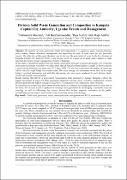| dc.contributor.author | Nabukeera, M. Sebyala | |
| dc.contributor.author | Boerhannoeddin, Ali | |
| dc.contributor.author | Noriza, Raja | |
| dc.date.accessioned | 2020-11-22T07:24:41Z | |
| dc.date.available | 2020-11-22T07:24:41Z | |
| dc.date.issued | 2014-10 | |
| dc.identifier.citation | Madinah, N.(2014).Division Solid Waste Generation and Composition in Kampala Capital City Authority, Uganda: Trends and Management.IOSR Journal of Environmental Science, Toxicology and Food Technology (IOSR-JESTFT).Volume 8, Issue 10 Ver. III | en_US |
| dc.identifier.issn | 2319-2402 | |
| dc.identifier.issn | 2319-2399 | |
| dc.identifier.uri | http://ir.iuiu.ac.ug/xmlui/handle/20.500.12309/739 | |
| dc.description | Recognition of waste generation trends and composition is a significant phase towards planning, policy making, budget allocation, management and improving the state of solid waste for any particular country. | en_US |
| dc.description.abstract | Recognition of waste generation trends and composition is a significant phase towards planning, policy making, budget allocation, management and improving the state of solid waste for any particular country. The objective of this paper therefore was to discover the generation of waste by the five divisions of Kampala Capital City Authority (KCCA) and private sector as a quick fix to guide policy makers to make informed decisions in proper management of waste in Kampala. In this paper, a qualitative method was used mainly observation and a few available documents. The researcher and research assistants recorded every refuse truck that off loaded at Kitezi Sanitary Landfill 24 hours a day for a period of one financial year (from July 2012-June 2013). The aim was to determine the number of tonnes per vehicle since the weigh bridge was nonfunctional. The waste tonnage was determined on the basis of the weigh bridge’s archived information and with this information, the total waste produced by each division (daily, weekly and monthly) was quantified. Results indicate that KCCA, a government representative body entrusted to manage Kampala, collects the biggest percentage of waste (64.36%) generated compared to private sector (35.64%), Furthermore, Central Division generates the highest tonnage of waste (64.171 tonnes) per year compared to other Divisions. In conclusion we propose that government allocates funds according to percentage generation of waste and on this basis, KCCA needs to place emphasis on reducing waste generation by encouraging sustainable reuse and recycling as well as addressing key success factors that include expertise, awareness of the public, strengthening partnerships to pool resources and promoting advanced technology | en_US |
| dc.language.iso | en | en_US |
| dc.publisher | IOSR Journal of Environmental Science, Toxicology and Food Technology (IOSR-JESTFT) | en_US |
| dc.relation.ispartofseries | IOSR Journal of Environmental Science, Toxicology and Food Technology (IOSR-JESTFT);Volume 8, Issue 10 Ver. III | |
| dc.relation.ispartofseries | IOSR Journal of Environmental Science, Toxicology and Food Technology (IOSR-JESTFT);Volume 8, Issue 10 Ver. III | |
| dc.subject | Solid waste generation | en_US |
| dc.subject | Trends | en_US |
| dc.subject | Characterization | en_US |
| dc.subject | Management | en_US |
| dc.subject | KCCA performance | en_US |
| dc.title | Division Solid Waste Generation and Composition in Kampala Capital City Authority, Uganda | en_US |
| dc.title.alternative | Trends and Management | en_US |
| dc.type | Article | en_US |

